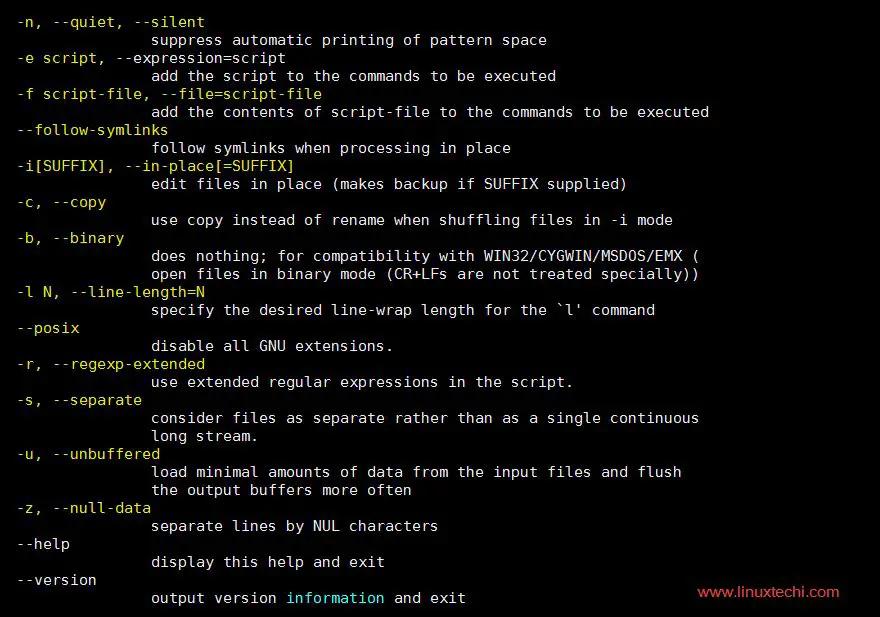https://www.linuxtechi.com/20-sed-command-examples-linux-users

Sed command or Stream Editor is very powerful utility offered by Linux/Unix systems. It is mainly used for text substitution , find & replace but it can also perform other text manipulations like insertion, deletion, search etc. With SED, we can edit complete files without actually having to open it. Sed also supports the use of regular expressions, which makes sed an even more powerful test manipulation tool.
In this article, we will learn to use SED command with the help some examples. Basic syntax for using sed command is,
sed OPTIONS… [SCRIPT] [INPUTFILE…]

Now let’s see some examples.
Example :8) Search and Replacing a string using sed
To search & replace a string from the file, we will use the following example,
Let’s assume i want to disable SELinux on CentOS or RHEL Severs

Sed command or Stream Editor is very powerful utility offered by Linux/Unix systems. It is mainly used for text substitution , find & replace but it can also perform other text manipulations like insertion, deletion, search etc. With SED, we can edit complete files without actually having to open it. Sed also supports the use of regular expressions, which makes sed an even more powerful test manipulation tool.
In this article, we will learn to use SED command with the help some examples. Basic syntax for using sed command is,

Now let’s see some examples.
Example :1) Displaying partial text of a file
With sed, we can view only some part of a file rather than seeing whole file. To see some lines of the file, use the following command,[linuxtechi@localhost ~]$ sed -n 22,29p testfile.txthere, option ‘n’ suppresses printing of whole file & option ‘p’ will print only line lines from 22 to 29.
Example :2) Display all except some lines
To display all content of a file except for some portion, use the following command,[linuxtechi@localhost ~]$ sed 22,29d testfile.txtOption ‘d’ will remove the mentioned lines from output.
Example :3) Display every 3rd line starting with Nth line
Do display content of every 3rd line starting with line number 2 or any other line, use the following command[linuxtechi@localhost ~]$ sed -n '2-3p' file.txt
Example :4 ) Deleting a line using sed command
To delete a line with sed from a file, use the following command,[linuxtechi@localhost ~]$ sed Nd testfile.txtwhere ‘N’ is the line number & option ‘d’ will delete the mentioned line number. To delete the last line of the file, use
[linuxtechi@localhost ~]$ sed $d testfile.txt
Example :5) Deleting a range of lines
To delete a range of lines from the file, run[linuxtechi@localhost ~]$ sed '29-34d' testfile.txtThis will delete lines 29 to 34 from testfile.txt file.
Example :6) Deleting lines other than the mentioned
To delete lines other than the mentioned lines from a file, we will use ‘!’[linuxtechi@localhost ~]$ sed '29-34!d' testfile.txthere ‘!’ option is used as not, so it will reverse the condition i.e. will not delete the lines mentioned. All the lines other 29-34 will be deleted from the files testfile.txt.
Example :7) Adding Blank lines/spaces
To add a blank line after every non-blank line, we will use option ‘G’,[linuxtechi@localhost ~]$ sed G testfile.txt
Example :8) Search and Replacing a string using sed
To search & replace a string from the file, we will use the following example,[linuxtechi@localhost ~]$ sed 's/danger/safety/' testfile.txthere option ‘s’ will search for word ‘danger’ & replace it with ‘safety’ on every line for the first occurrence only.
Example :9) Search and replace a string from whole file using sed
To replace the word completely from the file, we will use option ‘g’ with ‘s’,[linuxtechi@localhost ~]$ sed 's/danger/safety/g' testfile.txt
Example :10) Replace the nth occurrence of string pattern
We can also substitute a string on nth occurrence from a file. Like replace ‘danger’ with ‘safety’ only on second occurrence,[linuxtechi@localhost ~]$ sed ‘s/danger/safety/2’ testfile.txtTo replace ‘danger’ on 2nd occurrence of every line from whole file, use
[linuxtechi@localhost ~]$ sed 's/danger/safety/2g' testfile.txt
Example :11) Replace a string on a particular line
To replace a string only from a particular line, use[linuxtechi@localhost ~]$ sed '4 s/danger/safety/' testfile.txtThis will only substitute the string from 4th line of the file. We can also mention a range of lines instead of a single line,
[linuxtechi@localhost ~]$ sed '4-9 s/danger/safety/' testfile.txt
Example :12) Add a line after/before the matched search
To add a new line with some content after every pattern match, use option ‘a’ ,[linuxtechi@localhost ~]$ sed '/danger/a "This is new line with text after match"' testfile.txtTo add a new line with some content a before every pattern match, use option ‘i’,
[linuxtechi@localhost ~]$ sed '/danger/i "This is new line with text before match" ' testfile.txt
Example :13) Change a whole line with matched pattern
To change a whole line to a new line when a search pattern matches we need to use option ‘c’ with sed,[linuxtechi@localhost ~]$ sed '/danger/c "This will be the new line" ' testfile.txtSo when the pattern matches ‘danger’, whole line will be changed to the mentioned line.
Advanced options with sed
Up until now we were only using simple expressions with sed, now we will discuss some advanced uses of sed with regex,Example :14) Running multiple sed commands
If we need to perform multiple sed expressions, we can use option ‘e’ to chain the sed commands,[linuxtechi@localhost ~]$ sed -e 's/danger/safety/g' -e 's/hate/love/' testfile.txt
Example :15) Making a backup copy before editing a file
To create a backup copy of a file before we edit it, use option ‘-i.bak’,[linuxtechi@localhost ~]$ sed -i.bak -e 's/danger/safety/g' testfile.txtThis will create a backup copy of the file with extension .bak. You can also use other extension if you like.
Example :16) Delete a file line starting with & ending with a pattern
To delete a file line starting with a particular string & ending with another string, use[linuxtechi@localhost ~]$ sed -e 's/danger.*stops//g' testfile.txtThis will delete the line with ‘danger’ on start & ‘stops’ in the end & it can have any number of words in between , ‘.*’ defines that part.
Example :17) Appending lines
To add some content before every line with sed & regex, use[linuxtechi@localhost ~]$ sed -e 's/.*/testing sed &/' testfile.txtSo now every line will have ‘testing sed’ before it.
Example :18) Removing all commented lines & empty lines
To remove all commented lines i.e. lines with # & all the empty lines, use[linuxtechi@localhost ~]$ sed -e 's/#.*//;/^$/d' testfile.txtTo only remove commented lines, use
[linuxtechi@localhost ~]$ sed -e 's/#.*//' testfile.txt
Example :19) Get list of all usernames from /etc/passwd
To get the list of all usernames from /etc/passwd file, use[linuxtechi@localhost ~]$ sed 's/\([^:]*\).*/\1/' /etc/passwda complete list all usernames will be generated on screen as output.
Example :20) Prevent overwriting of system links with sed command
‘sed -i’ command has been know to remove system links & create only regular files in place of the link file. So to avoid such a situation & prevent ‘sed -i‘ from destroying the links, use ‘–follow-symklinks‘ options with the command being executed.Let’s assume i want to disable SELinux on CentOS or RHEL Severs
[linuxtechi@localhost ~]# sed -i --follow-symlinks 's/SELINUX=enforcing/SELINUX=disabled/g' /etc/sysconfig/selinuxThese were some examples to show sed, we can use these reference to employ them as & when needed. If you guys have any queries related to this or any article, do share with us.

No comments:
Post a Comment